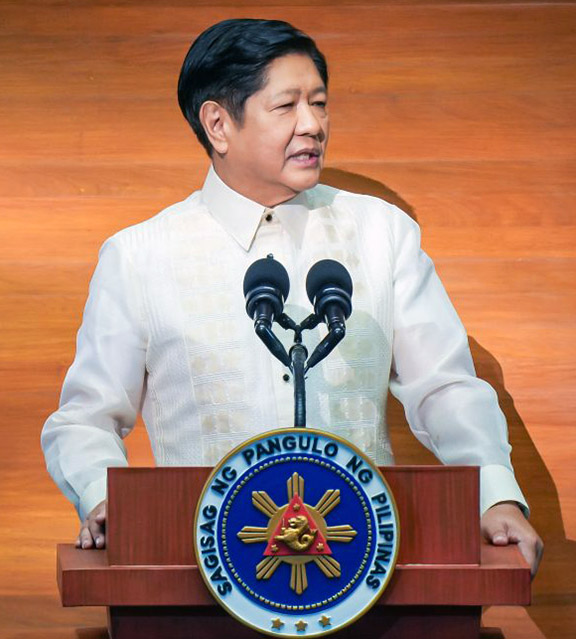-
Philippine infrastructure spending will stay at 5% to 6% of GDP, President Ferdinand Marcos Jr. says in his second State of the Nation address on July 24
-
Marcos says projects under his “Build Better More” program are “being vigorously implemented”
-
As of June 2023, more than 4,000 km of roads and bridges had been built, maintained, and upgraded while airport and port development projects had been completed
-
More than 1,000 km of railway projects had been started
President Ferdinand Marcos Jr. promised to pursue infrastructure projects to fuel economic growth during his second State of the Nation Address on July 24.
Before an assembly of members of the Senate and the House of Representatives, Cabinet members and foreign diplomats, Marcos said: “One of the keys to continuing economic growth is infrastructure development. So, we will build better, and more.”
He spoke of the thousands of kilometers of roads and bridges his administration has built or are under construction, as heavy rain brought by Typhoon Egay (international name: Doksuri) pummeled Metro Manila and nearby provinces.
The projects under his administration’s “Build Better More” program are now “currently in progress and being vigorously implemented,” the President said.
The program includes 194 infrastructure priority projects – in areas of physical connectivity, water resources, agriculture, health, digital connectivity, and energy – worth a total of P8.3 trillion.
Marcos noted that 124 of the projects under the program are new, while 83% of the total are in physical connectivity – such as roads, bridges, seaports, airports, and mass transportation already interlinked.
“The underlying logic to our infrastructure development is economic efficiency. We are opening up all gateways to mobilize goods and services at less cost and in less time, and ultimately, to drive the economy forward,” Marcos said.
Road networks plans, he noted, must link not only the country’s three major islands, but all prospective sites of economic development.
He cited in particular the 1,200-km Luzon Spine Expressway Network Program (LSENP), which will effectively connect the Ilocos region up north to the Bicol region down south from 20 hours currently to just nine hours of travel.
A flagship program of the previous administration under the Department of Public Works and Highways, the LSENP is a network of high-speed expressways, including existing ones, that connects north and south Luzon.
Under the “mega bridge” program, Macros said 12 bridges totaling 90 km long will be built during his term. This includes the 32-km Bataan-Cavite Interlink Bridge, 32.47-km Panay-Guimaras-Negros Island Bridges, and the P3.86-km Samal Island-Davao City Connector Bridge.
As of June this year, Marcos said more than 4,000 km or roads and bridges around the country had been constructed, maintained, and upgraded.
Crucial airport and port development projects across the country have also been completed, including Cebu’s Pier 88 smart port, and the new passenger terminal buildings of Clark International Airport and the Port of Calapan.
Marcos said several railway projects with a total length of more than 1,000 km were initiated.
He said this includes the southern leg of the North-South Commuter Railway (NSCR) system, or the P73.25 billion South Commuter Railway Project (Alabang-Calamba leg), which officially broke ground on July 3.
A carryover project, the 147.26-km NSCR system aims to seamlessly connect Clark, Pampanga and Calamba, Laguna by linking Metro Manila to its neighboring provinces from 4-4.5 hours travel time to just less than two hours.
Marcos said intermodal connectivity “will also be a primary consideration.”
“Roads, bridges and mass transport systems will be interconnected. This network will provide access and passage to vital and bustling economic markets, such as agriculture hubs, tourism sites, and key business districts,” he added.
For strategic financing, Marcos said some of the nation’s high-priority projects can now look to the newly established Maharlika Investment Fund (MIF), “without the added debt burden.”
He said in pooling a small fraction of the considerable but underutilized government funds, the MIF “shall be used to make high-impact and profitable investments, such as the Build Better More program.”
The newly enacted MIF is the Philippines’ first-ever sovereign investment fund aimed at benefiting the country in several ways.
Hours before he arrived at the Batasan legislative building in Quezon City, traffic on Commonwealth Avenue was reported to be very thin, as the approach of Egay forced offices and schools to close for the day, and two groups of jeepney drivers went on a strike to protest government pressure on the operators and drivers to replace their units with costlier airconditioned minibuses.
At 5pm on July 24, Egay was steadily intensifying as it 10km per hour as it moved north-northwest on a trajectory that would swipe the northern part of Cagayan province around 2am on July 26 and slam across the Batanes islands as it plods towards mainland China.
Egay has maximum sustained winds of 155 km/hour near the center and gustiness of up to 190 km/hour, the Philippine weather bureau said. – Roumina Pablo





